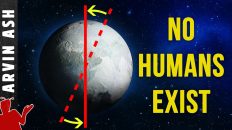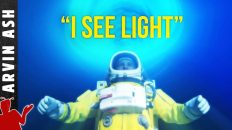The double slit experiment – Does consciousness create reality? Quantum mechanics shows us that particles are in superposition, meaning they can exist in different states and even multiple places at the same time. They are nothing more than waves of probabilities, until the moment that they are measured. One interpretation of this phenomenon is that the measurement being made requires a measurer, or a conscious observer. If this is correct, then it implies that consciousness has to be is an integral part of creating the world that we observe. Could this consciousness then be required for creating reality? Does this mean that there would be no reality without consciousness?
Experiments can show that what we think of as particles behave like waves. Waves of probabilities. This is the foundation of Quantum mechanics. The famous double slit experiment illustrates this. What is bizarre is that when you try to find out what’s going on at the slits by placing a detector at the two slits to try to figure out which slit the individual atoms are going through – the “WHICH WAY” information, they all of a sudden stop behaving like waves, and behave like particles.
Why do atoms and other particles behave this way? There are many interpretations of this phenomenon.
The most widely accepted interpretation, called the Copenhagen interpretation, was devised in 1925 by Neils Bohr and Werner Heisenberg at the University of Copenhagen. Their theory proposed that the atom when it is not measured, is not distinct. But the Copenhagen interpretation does not say anything about consciousness. But what is measurement after all?
Does measurement take place at the instrument that measures it? Does measurement necessarily require a consciousness? This is called the “measurement problem of quantum mechanics.” Physicists do not universally agree on a resolution. There are various interpretations.
One such interpretation is called the von Neumann–Wigner interpretation. This says that in the long chain of measurement, the collapse occurs at the moment that a consciousness interprets the measurement. The consciousness of the physicist is making the particle distinct. And without this consciousness, the atom would just be a wave of probabilities.
One fascinating interpretation is the many worlds interpretation. It was put forth by Hugh Everett in 1957. This theory postulates that there is NEVER any collapse, that we may be a measuring it in our reality, but there is no measurement happening in a different reality, and the wave function continues in that different branch of reality. But at some branch of reality, the particle collapse never actually happens. There is some new evidence that seems to support this idea of multiple realities. A paper published just this year in 2019 by Massimiliano Proietti at Heriot-Watt University in Edinburgh Seems to support the idea that at least two equally provable realities could exist at a quantum level at the same time.
So what is the correct answer? First let’s summarize what we know for sure – we know that measurement that records the which-way information of a particle indeed collapses a particle’s uncertainty wave. This particle collapse is consistent forward or backward in time as well, as shown by the delayed choice quantum eraser experiment.
As for many worlds, the equation allow it to be true, but since the other worlds appear to be inaccessible to us, there is no way to prove it. So just because it could be true, doesn’t mean it is true.
The Copenhagen interpretation is the most widely accepted, and in my view likely correct. It does not require a consciousness to interpret or even observe the results. I think the problem is with the word “observation” – which for many people seems to imply that someone has to look with their eyes. And eyes have a consciousness behind them.
But in quantum mechanics, this is not what the word observation means. So this unfortunate terminology of “observation” is what causes the confusion. In quantum mechanics an observation simply means the interaction of two quantum states that can collapse each other’s probability wave function. Does consciousness play a role. Probably not. And there is some new evidence that seems to show this.
A paper published by Shan Yu and Danko Nikolic in 2011 showed that a conscious observer was not necessary for the collapse. Their experiments measured the which-way information of a particle, but recorded it in the state of an atom. This information was not available to a conscious observer, but was preserved in the atom, in other words, it was available to the universe. For conclusion, see video…
Citations:
Two realities: https://www.technologyreview.com/s/613092/a-quantum-experiment-suggests-theres-no-such-thing-as-objective-reality/
Delayed choice quantum eraser: https://en.wikipedia.org/wiki/Delayed-choice_quantum_eraser
Yu and Nikolic: https://arxiv.org/abs/1707.01346







